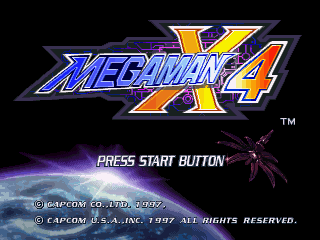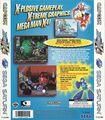Mega Man X4
From Sega Retro
This short article is in need of work. You can help Sega Retro by adding to it.
| Mega Man X4 | |||||
|---|---|---|---|---|---|
| System(s): Sega Saturn | |||||
| Publisher: Capcom | |||||
| Developer: Capcom | |||||
| Genre: Action | |||||
| |||||
Mega Man X4, known as Rockman X4 in Japan, is the fourth game in the "Mega Man X" franchise - a spinoff of the Mega Man franchise with more complex platforming and a darker storyline. It is the sequel to Mega Man X3. The game was released on the Sega Saturn and the PlayStation in Japan and the US, but other international releases only got the PlayStation version. The Special Limited Edition version, released only in Japan, comes with a Mega Man figure model kit.
Mega Man X4 was the first Mega Man X game designed for 32-bit hardware, rather than ported upwards, and so the character sprites were redrawn to take advantage of the ability to have larger sprites and more vibrant palettes. Another major change from Mega Man X3 was in the handling of the character Zero; he was now selectable from the start of the game as a character that can be played the whole way through, with his own storyline perspective, and an entirely different, melee-combat-oriented playstyle compared to X. Besides these changes, however, gameplay is otherwise similar to its previous entry.
Plotline
The plot for Mega Man X4 is presented by both fully-animated full motion video (FMV) cutscenes and in-game text. The storyline differs slightly depending on whether the player chooses X or Zero. Taking place in an ambiguous year in the 22nd century (21XX) and following the third defeat of the "Maverick" robot Sigma, Cain Labs issues an initiative to create a supplementary military force to complement the "Maverick Hunters". The army, called the "Repliforce", is a strict regime led by General and his second-in-command, Colonel.
Six months following the inception of the group, Cain Labs finds its methods to be ineffective, questionable, and potentially dangerous in the Maverick defense. To make matters worse, behind the scenes, General has been meeting with a mysterious figure who plots the Hunters' demise, insinuating that they are a significant threat to the jurisdiction of the Maverick Hunters. Mayhem breaks out when the Sky Lagoon, a massive floating city, is sent crashing down onto the city below it, killing millions of civilians, humans and Reploids alike. The game begins here where either X or Zero is dispatched to investigate possible causes of the disaster only to become entangled, once again, in a struggle against Sigma to save the world.
In X's storyline, X partners up with a robot named Double, who turns out to be a spy for Sigma.
In Zero's storyline, the strained relations with Repliforce cause a rift between the bond of himself, his girlfriend Iris, and Colonel, who is Iris' brother. Zero also learns some shocking secrets about his past from Sigma.
Bad Voice Acting
Mega Man X4, like Mega Man 8, suffered from a localization job which involved subpar English language voice acting. A pivotal scene which shows a major character's demise is turned from tragic to comical merely by the poor vocal execution of Zero screaming "What am I fighting for?!", and as such the scene became a popular source of parody and meme in videogame pop-culture.
Version Differences
- The themes for the opening stage boss (Eregion) and the second part of Frost Walrus' stage include an introduction heard exclusively in this version of the game. Since the PlayStation version is the one represented in the game's official soundtrack, it is interesting to note the obscurity of this information as well as its absence in the official release (where the tracks generally have definite endings not heard in-game).
- Some sound production differences for the game's sound effects and BGM are present, though not nearly to the extent as the previous Mega Man title for the console.
Production Credits
Producer: Keiji Inafune, Bamboo
Planner: Ohko, Mitsuru Endo, Hiroyuki Yamato
Programmer: Hisashi Kuramoto, Hiroki Bandoh, Syuichiro Chiboshi, Tomohiro Akizuki, Yuuji Hagiyama, Akihiro Kashimoto, Hideaki Motozuka
Object Design: Ikki Tazaki, Tsuyoshi Fujisawa, Nwo Hattori, Nottsu Man, Katsumi Toda, Obi Tomomi, Hayato Kaji, Nobuyoshi Mihara
Scroll Design: Natsue Ueda, Shimoyan, Mayumi Yoshioka, J R, Kita‑One, Kentaroh Ono
Title Design: Ukabin
Illustrations: Manashi, Hyper Mino, Sensei, Toyozo, Hideki
Music: Toshihiko Horiyama
Sound Effect: More Rich
Voice Actor (Japanese): Kentarou Ito, Ryotaro Okiayu, Ryuzaburoh Ohtomo, Jin Yamanoi, Yūko Mizutani, Yasunori Matsumoto, Mugihito, Issei Futamata, Kazuo Oka, Mari Maruta, Osamu Hosoi, Takashi Nagasako, Toranori Yoshikawa, Hiroyuki Yoshino, Takeshi Aono
Voice Actor (Overseas): Ruth Shiraishi, Wayne Doster, Mark Hagan, Matthew Meersbergen, John O'Corner, Jermy Felton, Michelle Gazepis, Charlie Fontana, Issei Futamata, Kazuo Oka, Mari Maruta, Osamu Hosoi, Takashi Nagasako
Opening Theme - "Makenai Ai ga Kitto aru"
Ending Theme - "One More Chance"
- Words by: Goroh Matsui
- Music by: Tetsuji Hayashi
- Arranged by: Takahiro Tashiro
- Song by: Yukie Nakama
Animation Staff
- Xebec: Nobuyoshi Habara, Shinji Takagi, Shinichi Yamaoka, Hideyuki Motohashi, Meijyu Maeda, Rieko Nakai, Masahiro Satoh, Kanami Sekiguchi, Minoru Ueta, Ryota Niino, Miho Asano, Masakazu Kawazoe, Yuriko Ikehara, Yūko Kami, Nobuo Horii, Youko Ito, Shingo Adachi, Ryuji Fujita, Masaru Echigoya, Kaori Takahashi, Ayumi Tsukamoto, Mitsuko Sekimoto, Hiromi Aoki, Shizuko Kawabata, Kazuyo Ikeda, Natsuyo Ban, Masaki Kimura, Hisaaki Sakabe
- K Production
- Keison Production
- Koni Production
- Marix
- Maki Production
- Trans Arts: Yukio Sugiyama, Hiroki Sekito, Haruhiko Tsumura, Saori Kibe, Hiroaki Matsuzawa, Tomohiro Baba, Chisato Asai, Takahiro Wada
- Production AI: Yoshimi Umino, Hachidai Takayama, Fumie Kawai, Fuyuki Sakanoue, Megumi Ogawa, Yukiko Ogawa, Nobuko Akutsu, Tomoko Takamura, Motoko Iwahashi, Saori Ishibiki
Special Thanks: Koji Nakajima, Takuya Shiraiwa, Erik Suzuki, Jun Takahashi, Takayuki Umezu, Ayumi Terada, Shinichi Sato, Tetsuya Tabuchi, Yoshihiro Sudo, Takeshi Kawano, Norikazu Fujikawa
- Bandai: Katsuhiro Izumi, Takeshi Inoue
- ...and All Capcom Staff
General Producer: Noritaka Funamizu
Executive Producer: Yoshiki Okamoto
Presented by: Capcom
Physical Scans
| Sega Retro Average | ||||||||||||||||||||||||||||||||||||||||||||||||||||||||||||||||
|---|---|---|---|---|---|---|---|---|---|---|---|---|---|---|---|---|---|---|---|---|---|---|---|---|---|---|---|---|---|---|---|---|---|---|---|---|---|---|---|---|---|---|---|---|---|---|---|---|---|---|---|---|---|---|---|---|---|---|---|---|---|---|---|---|
|
| 79 | |
|---|---|
| Based on 12 reviews | |
| Saturn, JP (Satakore) |
|---|
| Mega Man games for Sega systems | |
|---|---|
| Mega Man: The Wily Wars (1994) | |
| Mega Man (1995) | |
| Mega Man X3 (1996) | Mega Man 8 (1997) | Mega Man X4 (1997) | Super Adventure Rockman (1998) | |
| Unlicensed Mega Man games for Sega systems | |
| Rockman X3 (1996) | |
| Mega Man related media | |
| Rockman 8: Metal Heroes Hisshou Kouryaku Hou (1997) | |
- ↑ Ação Games, "Setembro 1997" (BR; 1997-xx-xx), page 10
- ↑ Electronic Gaming Monthly, "December 1997" (US; 1997-1x-xx), page 198
- ↑ Famitsu, "1997-08-08" (JP; 1997-07-25), page 1
- ↑ Freak, "9/97" (IL; 1997-xx-xx), page 1
- ↑ GamePro, "December 1997" (US; 1997-xx-xx), page 184
- ↑ MAN!AC, "10/97" (DE; 1997-09-10), page 49
- ↑ Mega Console, "Novembre 1997" (IT; 1997-xx-xx), page 78
- ↑ Saturn Fan, "1997 No. 18" (JP; 1997-09-12), page 82
- ↑ Saturn Power, "November 1997" (UK; 1997-09-17), page 81
- ↑ Sega Saturn Magazine, "April 1998" (UK; 1998-03-11), page 71
- ↑ Sega Saturn Magazine, "1997-27 (1997-08-08)" (JP; 1997-07-25), page 196
- ↑ Sega Saturn Magazine, "Readers rating final data" (JP; 2000-03), page 12








